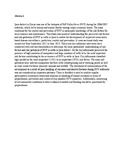Perceived risk factors and risk pathways of Rift Valley fever in cattle in Ijara district, Kenya: original research

View/
Date
2014Author
Owange, Nelson O
Ogara, William O
Kasiiti, Jacqueline
Gathura, Peter B
Okuthe, Sam
Sang, Rosemary
Affognon, Hippolyte
Onyango-Ouma, Washington
Landmann, Tobias TO
Mbabu, Murithi
Language
enMetadata
Show full item recordAbstract
Ijara district in Kenya was one of the hotspots of Rift Valley fever (RVF) during the 2006/2007 outbreak, which led to human and animal deaths causing major economic losses. The main constraint for the control and prevention of RVF is inadequate knowledge of the risk factors for its occurrence and maintenance. This study was aimed at understanding the perceived risk factors and risk pathways of RVF in cattle in Ijara to enable the development of improved community-based disease surveillance, prediction, control and prevention. A cross-sectional study was carried out from September 2012 to June 2013. Thirty-one key informant interviews were conducted with relevant stakeholders to determine the local pastoralists' understanding of risk factors and risk pathways of RVF in cattle in Ijara district. All the key informants perceived the presence of high numbers of mosquitoes and large numbers of cattle to be the most important risk factors contributing to the occurrence of RVF in cattle in Ijara. Key informants classified high rainfall as the most important (12/31) to an important (19/31) risk factor. The main risk pathways were infected mosquitoes that bite cattle whilst grazing and at watering points as well as close contact between domestic animals and wildlife. The likelihood of contamination of the environment as a result of poor handling of carcasses and aborted foetuses during RVF outbreaks was not considered an important pathway. There is therefore a need to conduct regular participatory community awareness sessions on handling of animal carcasses in terms of preparedness, prevention and control of any possible RVF epizootics. Additionally, monitoring of environmental conditions to detect enhanced rainfall and flooding should be prioritised for preparedness.
Citation
Owange, N. O., Ogara, W. O., Kasiiti, J., Gathura, P. B., Okuthe, S., Sang, R., ... & Mbabu, M. (2014). Perceived risk factors and risk pathways of Rift Valley fever in cattle in Ijara district, Kenya: original research. Onderstepoort Journal of Veterinary Research, 81(1), 1-7.Publisher
University of Nairobi
